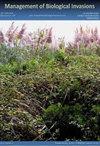密西西比河上游本地和入侵鱼类对100马力船马达声刺激的行为反应
IF 1.5
4区 环境科学与生态学
Q3 BIODIVERSITY CONSERVATION
引用次数: 1
摘要
声学威慑目前正在考虑部署在战略瓶颈,如主要河流的水闸和水坝,以阻止入侵鲤鱼的上游运动。先前的研究表明,鳙鱼和鲢鱼(分别为Hypophthalmichthys nobilis和H. molitrix)对100马力舷外马达产生的宽带录音回放表现出负的声性。然而,人们担心声音威慑可能会影响密西西比河上游非目标本地鱼类的运动。我们评估了宽带水声威慑对本地捕食动物[大嘴水牛(Ictiobus cyprinellus),水道鲶鱼(Ictalurus punctatus)和鳍鱼(Pimephales promelas)],入侵捕食动物[鳙鱼,鲤鱼(Cyprinus carpio),草鱼(Ctenopharyngodon idella)和鲢鱼]以及本地非捕食动物[美洲鳗(Anguilla rostrata),沙棘鱼(Dorosoma cepedianum)]的潜在影响。杂交条纹鲈(M. saxatilis × M. chrysops)、湖鲟(Acipenser fulvescens)和白鲟(Polyodon spathula)]。鱼被暴露在宽带声音(60-10000 Hz)的回放中,并对它们的行为进行评估。鳙鱼对刺激表现出较强的负趋声性反应(平均连续反应12.3±7.5 (SD)),鲢鱼和草鱼表现为中等反应(分别为4.5±5.2和3.8±3.5),鲤鱼表现为低反应(1.3±1.9)。在本地鱼类中,只有大嘴野牛(2.1±2.9个反应)和杂交条纹鲈(0.3±0.5个反应)对声刺激有明显的反应。基于这种小规模的行为筛选,声学威慑应该对本地物种的影响最小;然而,需要更大的池塘和现场试验来证实这一发现。本文章由计算机程序翻译,如有差异,请以英文原文为准。
Behavioral responses of native and invasive fishes of the Upper Mississippi River to 100 hp boat motor acoustic stimulus
Acoustic deterrents are currently being considered for deployment at strategic bottlenecks, such as lock and dams of major rivers, to deter upstream movement of invasive carp. Previous studies have demonstrated that bighead and silver carp ( Hypophthalmichthys nobilis and H. molitrix , respectively) display negative phonotaxis to playbacks of broadband sound recordings produced from a 100 hp outboard boat motor. However, there is concern that acoustic deterrents may impact the movement of non-target native fishes in the Upper Mississippi River. We evaluated the potential impacts of a broadband underwater acoustic deterrent on native ostariophysans [bigmouth buffalo ( Ictiobus cyprinellus ), channel catfish ( Ictalurus punctatus ) and fathead minnow ( Pimephales promelas )], invasive ostariophysans [bighead carp, common carp ( Cyprinus carpio ), grass carp ( Ctenopharyngodon idella ) and silver carp], and native non-ostariophysans [(American eel ( Anguilla rostrata ), gizzard shad ( Dorosoma cepedianum ), hybrid striped bass ( M. saxatilis × M. chrysops ), lake sturgeon ( Acipenser fulvescens ) and paddlefish ( Polyodon spathula )]. Fish were exposed to playback of the broadband sound (60–10000 Hz), and their behavior was evaluated. Bighead carp showed a strong negative phonotaxis response to the stimulus [12.3 ± 7.5 (SD) mean consecutive reactions], silver carp and grass carp showed moderate responses (4.5 ± 5.2 and 3.8 ± 3.5 reactions), and common carp displayed low responses (1.3 ± 1.9 reactions). Of the native fish, bigmouth buffalo (2.1 ± 2.9 reactions) and hybrid striped bass (0.3 ± 0.5 reactions) were the only species to demonstrate observable response to the acoustic stimulus. Based on this small-scale behavioral screening, acoustic deterrents should have minimal impact on native species; however, larger pond and field trials are necessary to confirm this finding.
求助全文
通过发布文献求助,成功后即可免费获取论文全文。
去求助
来源期刊

Management of Biological Invasions
Agricultural and Biological Sciences-Ecology, Evolution, Behavior and Systematics
CiteScore
3.40
自引率
6.70%
发文量
21
审稿时长
16 weeks
期刊介绍:
Management of Biological Invasions, established in 2010 by Dr. Elias Dana, is an open access, peer-reviewed international journal focusing on applied research in biological invasions in aquatic and terrestrial ecosystems from around the world. This journal is devoted to bridging the gap between scientific research and the use of science in decision-making, regulation and management in the area of invasive species introduction and biodiversity conservation.
Managing biological invasions is a crisis science, with Management of Biological Invasions aiming to provide insights to the issues, to document new forms of detection, measurements and analysis, and to document tangible solutions to this problem.
In addition to original research on applied issues, Management of Biological Invasions publishes technical reports on new management technologies of invasive species and also the proceedings of relevant international meetings. As a platform to encourage informed discussion on matters of national and international importance, we publish viewpoint papers that highlight emerging issues, showcase initiatives, and present opinions of leading researchers.
 求助内容:
求助内容: 应助结果提醒方式:
应助结果提醒方式:


